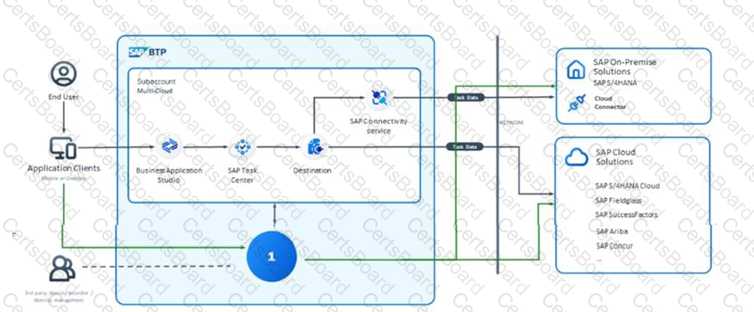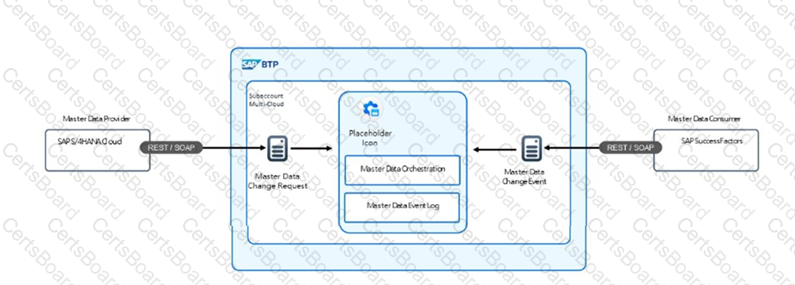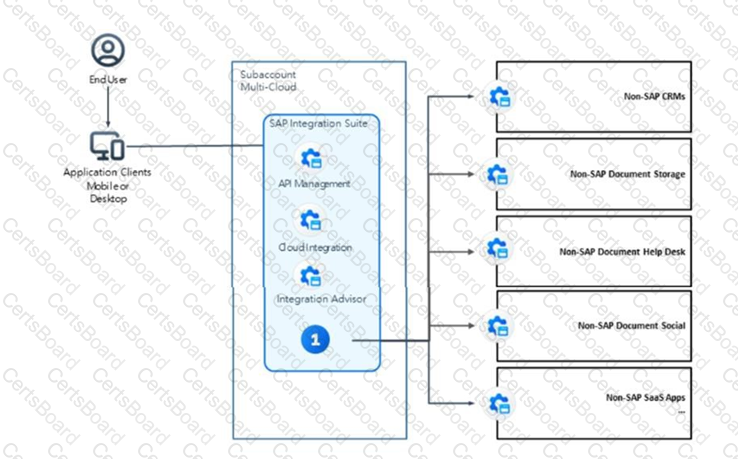A customer is struggling with organizing and managing the immense amount of data generated by the business. They have been told about several possible solutions that SAP BTP offers; however, they are confused about which solutions they should use. Their data is highly structured and includes customers, sales orders, and purchase orders. The data needs to be stored for both transactional and reporting purposes in a vector database. The client prefers to use the latest SAP solutions.
Which of the following SAP BTP solutions would you recommend?
You are a solution architect and your client has recently completed a merger and acquisition. Your client uses SAP S/4HANA Cloud Public Edition and the acquired company is using SAP ECC 6.0. For business and legal reasons, the users of the acquired company cannot yet be added to the global user directory. The acquired users still need access to the custom application.
Given the attached diagram, which solution would you recommend to your client in "1" to enable this access?

A fit-to-standard analysis determined that the provided SAP Fiori App for SAP S/4HANA Cloud private edition was insufficient based on existing business requirements, and that a new front-end app must be built.
As a solution architect, you are asked to propose a solution and are told the following:
•The backend logic running on SAP S/4HANA Cloud private edition is sufficient and an appropriate remote API for create, read, update, and delete (CRUD) operations exists.
•The front-end app must be able to run on a variety of devices such as mobile phones and tablets.
•Front-end app instances must scale up or down automatically based on administrator- provided scaling parameters.
Which of the following runtimes would be optimal for the new front-end app? Note: There are 2 correct answers to this question.
A new application is to be developed to help manage production orders. About 8000 users will be using the app, about 1000 of them concurrently. The app must run on mobile devices and plant managers themselves will be maintaining the app.
Which solutions should be used for the placeholder "1" in the attached diagram? Note: There are 2 correct answers to this question.

You are a solution architect helping to design a custom-built application for business users. You must follow these use case parameters:
•The application requires data solely from SAP S/4HANA Cloud public edition.
•The application supports create, read, update, and delete (CRUD) operations.
•If multiple backend protocols are applicable the one with the fastest performance is to be used.
Which of the following combinations would you recommend for the application design?
Which part of the SAP Al architecture is responsible for handling text input from end users?
The finance department is creating a series of reports for their line of business (LOB) users and would like to integrate the reports in a front-end portal. They would like the LOB users to maintain the portal, as opposed to IT. As a solution architect, they come to you to recommend which SAP BTP service best fits their needs.
Which service would you recommend?
The customer is looking to use an SAP BTP service to replicate master data objects across connected business applications. The service should be based off of the process integration style and the integration use case pattern as defined in the SAP Integration Solution Advisory Methodology.
The customer wants to use an SAP BTP service to synchronize the workforce person master data object between SAP S/4HANA Cloud and SAP SuccessFactors HXM Suite as part of the Hire to Retire process (for cloud deployment). They prefer a service that uses a "hub and spoke" model to enable the synchronization.
Which of the following SAP solution should the customer use as the "Placeholder Icon" (see attached diagram)?

A customer wants to design and build a mission critical application:
•The app will undergo frequent adjustments because business and legal changes will occur often.
•The application must be always ready for deployment to production.
•The deployment to production will be done manually by the IT department.
•Changes to the application code must be merged smoothly and easily so that the code remains stable.
As a solution architect, which SAP BTP solution best meets the customer requirements?
The following design (see attached diagram) uses third-party REST APIs that are publicly available through the internet.
Which capability of the SAP Integration Suite can be used in place of "1" in the diagram?



